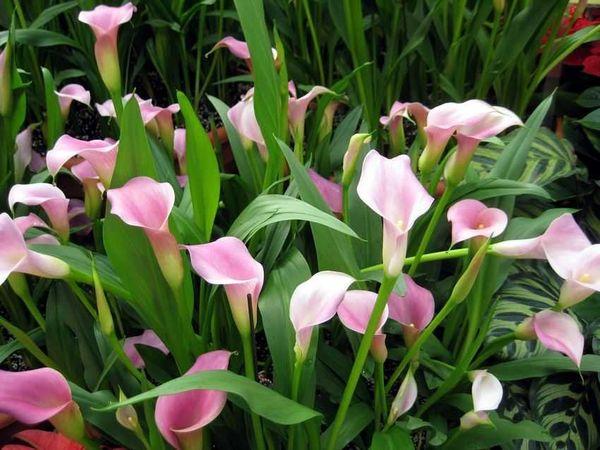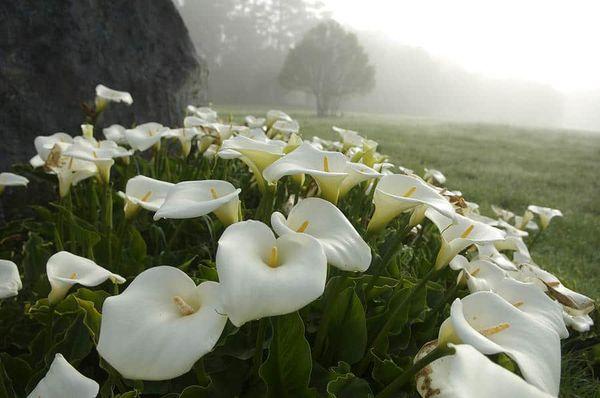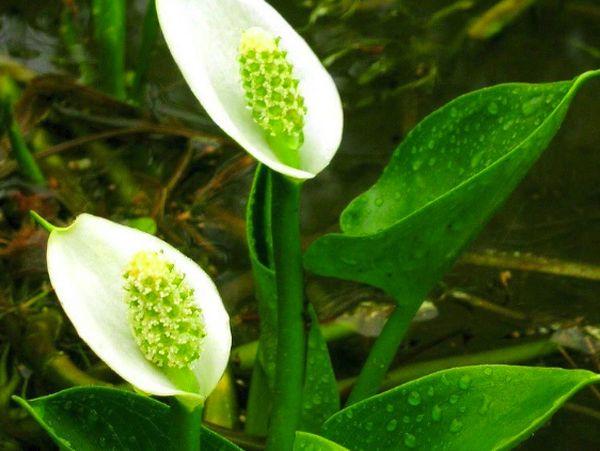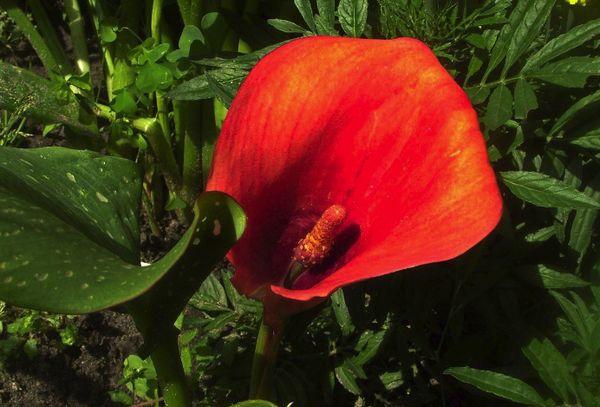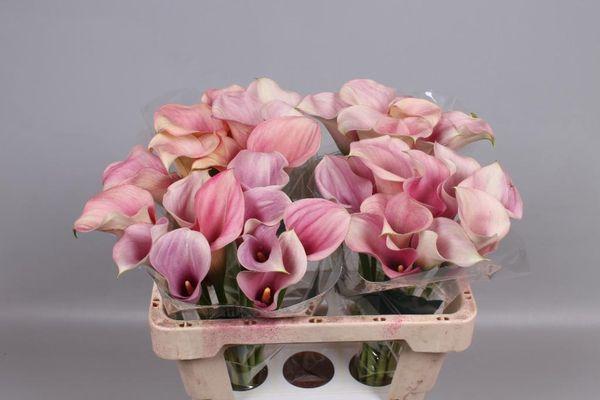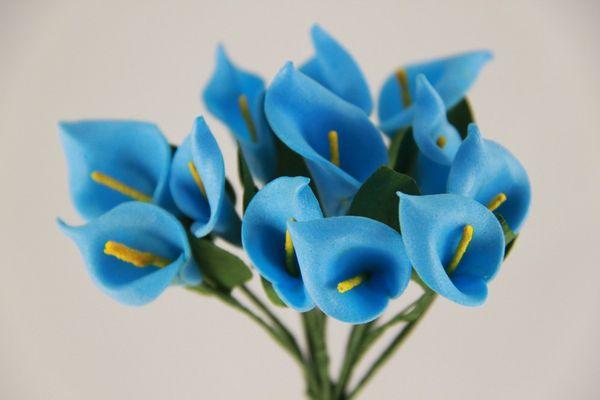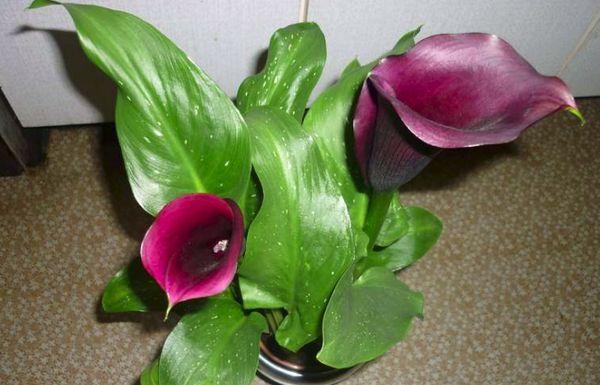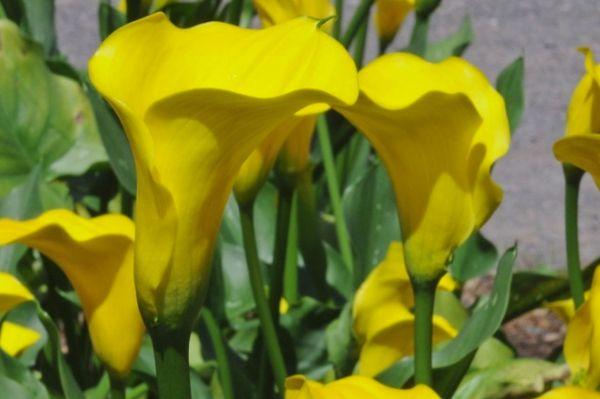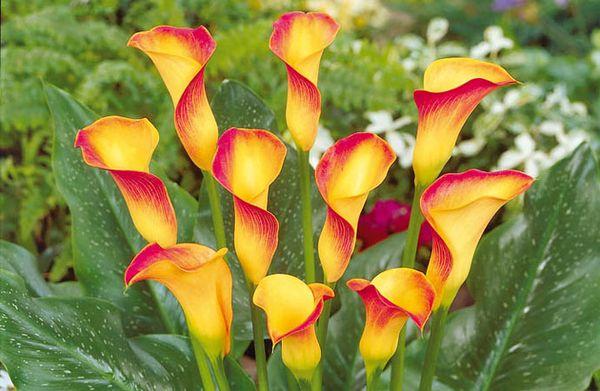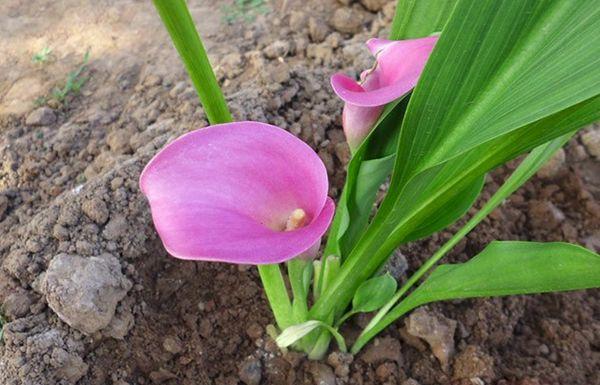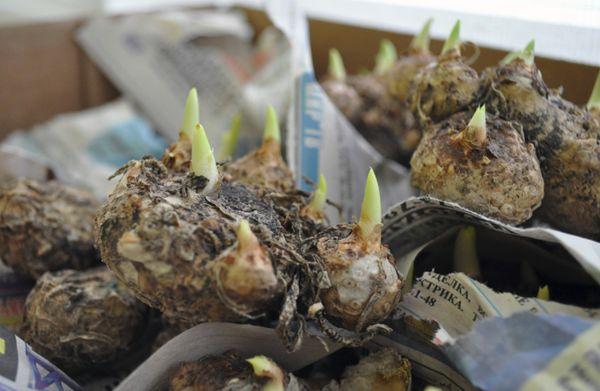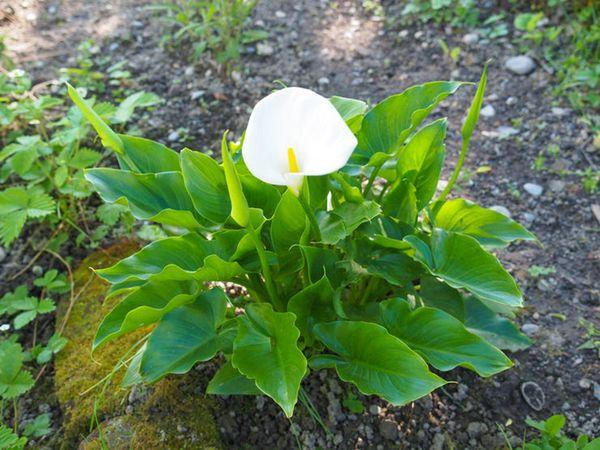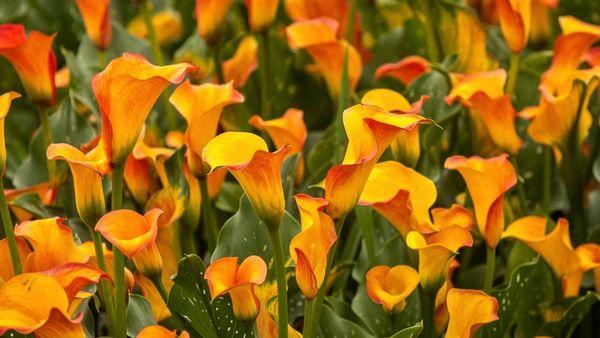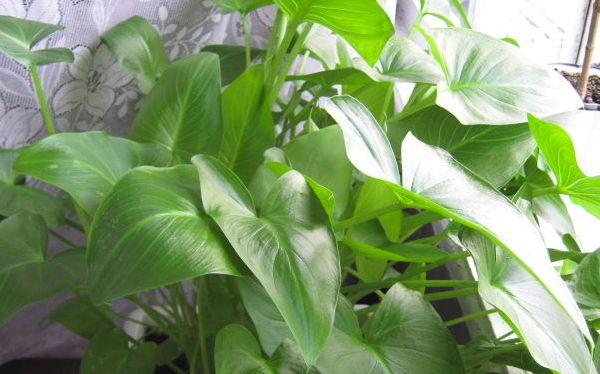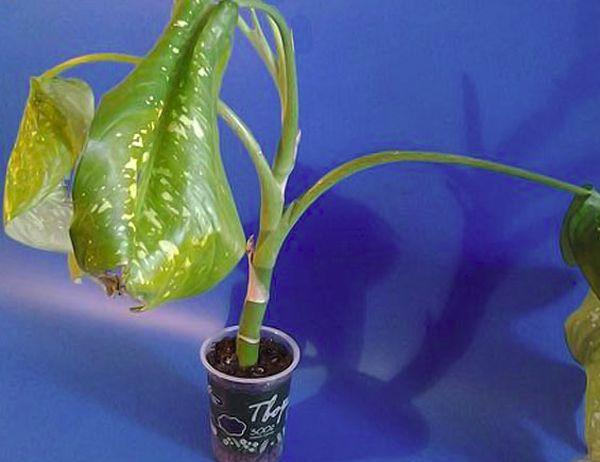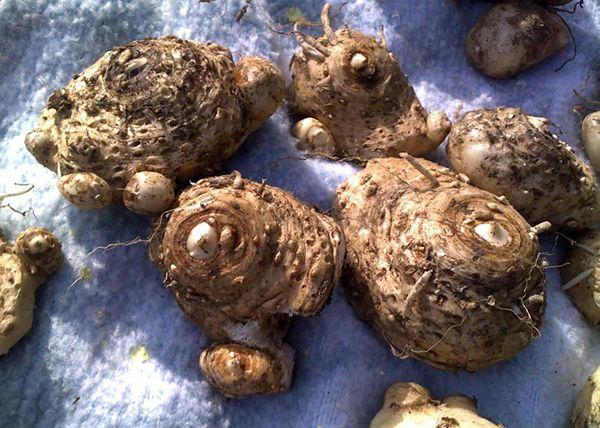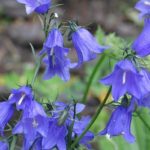Graceful callas have long attracted the attention of gardeners; planting and caring for them in the open ground require special attention. Callas are heat-loving flowers that bloom in early summer and bloom until autumn. They like frequent watering, potassium fertilizing and do not tolerate frost. They often reproduce by tubers, which are planted in the spring and dug out of the ground before the winter cold.
- Features and description of the flower
- Plant classification
- By type of garden flowers
- Ethiopian
- Elliott
- Remani
- Rhizomatous (swamp)
- By color variety
- Black
- Reds
- Yellow
- Purple
- Pink
- Burgundy
- White
- Orange
- Blue
- The best varieties for planting
- Cantor
- Mix
- The Snow Queen
- Chameleon
- Casper
- Mozart
- Remani
- Black Star
- Captain Promise
- Remanna
- Gold medal
- Rudolf
- Mango
- Garnet glow
- Paco
- Conditions necessary for the growth and flowering of the crop
- Lighting
- Temperature
- Required soil composition
- Humidity
- Growing a plant in the garden
- Disembarkation dates
- According to the plant variety
- Depending on the growing region
- Selecting planting material and planting site
- Preparing the garden plot
- Planting tubers in open ground
- How to properly care for callas
- Regularity of watering
- Spraying
- What fertilizers to apply
- Loosening the soil
- Calla lily pruning
- How to transplant calla lilies
- Main problems when growing
- Why do the leaves turn yellow and dry?
- Calla does not bloom
- Flower diseases
- Anthracnose
- Gray rot
- Bacterial rot
- Root rot
- What parasites are calla lilies susceptible to?
- Reproduction methods
- Tubers
- Dividing the bush
- Seeds
Features and description of the flower
Callas are perennial herbaceous plants from the Araceae family. Wild forms prefer marshy soils, can grow half submerged in water, and are distributed throughout the world. Calla has several names: calla grass, marsh grass, serpentine. Mainly African varieties are cultivated. Callas are grown for cutting for bouquets and compositions, as an indoor flower, and used in landscape (street) design.
All parts of the plant are poisonous when fresh. Callas are an unpretentious, shade-tolerant plant. Can grow on sandy, loamy soils with an acidic or neutral acidity level.
The shoots of the plant are creeping or erect, with a height (depending on the variety) of 25-150 centimeters. In some species the rhizome is creeping, in others it has the shape of a tuber. The leaves are large, heart-shaped, with a pointed tip, petiolate, basal, smooth, shiny.They can be green, plain or have white speckles on the surface.
The flowers are located on long bare petioles and consist of a yellowish spadix and spathe. The spadix is located inside, and outside it is surrounded by a funnel-shaped, bright and large bract-veil, which can be snow-white, yellow, scarlet, purple, pink, or orange.
The spadix itself is covered with tiny flowers. Callas bloom in summer. Pollinated by insects. The fruits are small, pomegranate-colored berries with seeds inside, and ripen a month after flowering (late August or September). Callas reproduce by seeds or tubers (dividing the rhizome).
Plant classification
Callas vary in height (from 25 to 155 centimeters), the structure of the root system (with rhizomes or tubers) and the color of the bract-veil.
By type of garden flowers
Callas differ in the type and color of the bract-spread surrounding the yellow spadix. It should be remembered that in all varieties, without exception, the color of the spathe turns green after pollination. The original color disappears.
Ethiopian
It is grown as an indoor and garden crop. Originally from South Africa. This is a rhizomatous plant with a snow-white bract-veil and a yellow spadix. The leaves are wide, heart-shaped, dense. The cover is funnel-shaped, widens at the top, and has a short-tubular shape at the base. The height of the plant sometimes reaches 155 centimeters. Used to create bouquets and landscape decoration. Popular varieties: Golden Goddess, Childsiana.
Elliott
A plant with yellow inflorescences and large, smooth, heart-shaped leaves. Propagated by tubers. The height of calla lilies is 50 centimeters. The leaves are wide, greenish with white specks. The cover is long, yellowish-green on the outside, yellow on the inside.Popular varieties: Selina, Black-eyed beauty.
Remani
Low crop (up to 50 centimeters in length) with pink flowers. Propagated by tubers. It has green leaves with white speckles. Spends the winter in hibernation. In autumn it drops all its leaves. Famous varieties: Bolero, Little Susie.
Rhizomatous (swamp)
A low plant (25 centimeters) growing in marshy areas. It has a thick, greenish, creeping rhizome located on the surface of the ground. The leaves are heart-shaped, pointed at the top. The cylindrical cob is surrounded by a snow-white inside, flat, ovoid blanket. Used in landscape design to decorate artificial ponds.
By color variety
Based on the color of the bract, callas are divided into white and colored. The white ones are descended from the Ethiopian variety. They are taller (up to 150 centimeters long), have a long rhizome, love moist soil, and prefer to grow in partial shade.
The ancestors of colorful plants are the pink calla lilies of Remani and the golden-yellow calla lilies of Elliott. The height of such flowers rarely exceeds 50 centimeters; they grow from a tuber. Plants are less demanding on soil moisture, but need good lighting.
Black
A rare variety of callas with a dark burgundy or dark purple bract. The plant grows up to 0.4-1 meters in height, has long, pointed, greenish leaves with speckles. Propagated by tubers and seeds. Famous varieties: Black Crusader, Black Star, Captain Palermo.
Reds
Elegant flowers with a rich red or slightly scarlet cover. Height - 0.4-1 meter. The leaves are heart-shaped, greenish, with white speckles. Refers to tuberous plants. Popular varieties: Majestic Red, Red Sox, Sanglow.
Yellow
Beautiful flowers with a soft lemon or rich tangerine cover. Plant height is 0.5-1 meter. The leaves are heart-shaped, shiny, greenish, pointed. Propagated by seeds and tubers. Known hybrids: Captain Amigo, Captain Cupid, Yellow Giant.
Purple
Graceful purple or lilac flowers with a wide cover wrapped in a narrow tube and at the top. The leaves are pointed, arrow-shaped, green, speckled. Tuber culture. Famous hybrids: Amethyst, Picasso, Ash Hayes.
Pink
Pink flowers hybridized from wild African species. Stem height is 30-90 centimeters. The leaves are oblong, green, growing from below. Propagated by seeds and tubers. Famous varieties: Zantedeschia white-spotted, Ethiopian, Zantedeschia Elliott, Remannia and others.
Burgundy
The plant is 0.4-0.9 meters high with a burgundy-colored cover. The leaves are green, speckled, heart-shaped. Tuber culture. Popular varieties: Schwarzwalder, Majestic Red.
White
Snow-white flowers symbolizing purity. Plant height is 50-150 centimeters. It has long, greenish, heart-shaped leaves. Famous varieties: Ethiopian childziana, Hazmanta Ethiopian, Hercules, Cameo.
Orange
Beautiful flowers with an orange blanket. Height - 30-70 centimeters. The leaves are oblong, green, speckled. Tuber culture. Popular varieties: Mango, San Remo.
Blue
Flowers symbolizing calm and nobility. The bract-bract has a soft blue or deep blue color. The leaves are oblong, heart-shaped, greenish. Famous varieties: Ice blue, Teal blue, Merlin blue.
The best varieties for planting
Callas are divided into tuberous (Remani, Elliott) and rhizomatous (Ethiopian).Based on these varieties, a huge number of varieties have been bred. Derived from the Ethiopian variety, the cultivars have white inflorescences and tall stems. Tuberous callas (Remani, Elliott) gave rise to low-growing, multi-colored varieties.
Cantor
Exquisite dark purple, waxy flowers. The height of the crop rarely exceeds 60 centimeters. The leaves are greenish, with white dashes. Flowering - from July to September.
Mix
Culture 40-60 centimeters high. It has inflorescences of various shades. The leaves are vertical, spear-shaped. Blooms for one month. It reproduces most often by tubers.
The Snow Queen
This is a garden calla with snow-white, almost transparent leaves with greenish edges. The flowers stand out effectively against the background of white foliage, the bracts of the calla lilies are a rich pink hue.
Chameleon
A delicate plant with cream, slightly pinkish and yellowish flowers. Forms a lush rosette of wide, greenish leaves with white speckles. The height of the crop is no more than 65 centimeters.
Casper
A low plant with a lush rosette of green, arrow-like leaves and bluish peduncles. It reproduces most often by tubers. Blooms from July to August.
Mozart
A plant with a lush rosette of dark green, white speckled, wide leaves and peduncles with bright orange, slightly reddish flowers. The height of the crop is about 75 centimeters.
Remani
This variety has beautiful pink flowers. The leaves are wedge-shaped, greenish, growing from the base of the stem.
Black Star
It is distinguished by an interesting inflorescence of a dark burgundy hue. The leaves are narrow, spear-like. The height of calla lilies is 60-70 centimeters. Blooms all summer long.
Captain Promise
A showy plant with dark purple flowers. Grows up to 55-65 centimeters.The leaves are large, dark green, with rare light splashes. Blooms throughout the summer.
Remanna
A lush plant with pink flowers and greenish, oblong leaves. Reaches a height of 40-70 centimeters.
Gold medal
A beautiful, low plant with graceful rich yellow flowers. The leaves are oblong and arrow-shaped. Blooms from July to August.
Rudolf
A dark burgundy, funnel-shaped flower on a long stem. The plant forms a lush rosette of large greenish, speckled leaves and several flower stalks. Height - 50 centimeters.
Mango
A low plant with a lush rosette of large, dark green leaves with small light specks. Flowers are deep orange. Blooms from July to August.
Garnet glow
A beautiful flower 60 centimeters high with a lush rosette of green, large, oblong leaves. In early June, pale pink inflorescences appear. Calla blooms for almost 3 months.
Paco
An exotic-looking plant with soft purple flowers. The leaves are oblong, dark green, and resemble arrowheads. It blooms for 1.5 months, from July to September.
Conditions necessary for the growth and flowering of the crop
Garden callas grow only in spring and summer, and in the fall, before winter, the tubers or rhizomes of the plant are dug out of the ground. This heat-loving crop can be pre-planted as seedlings and transferred to the flowerbed only at the end of May. During the same period, calla lily tubers are usually buried in open ground.
Lighting
Callas need to be provided with good lighting; in the shade they will grow and develop poorly. The plant easily tolerates partial shade. In the summer midday heat, the leaves need to be covered from the scorching sun. In too sunny areas, as well as in the shade, callas may not bloom.
Temperature
In spring and summer, the optimal temperature for callas is 15-25 degrees Celsius. Plants are transferred to the flowerbed only at the end of May, when the air has warmed up well and the threat of night frosts has passed.
Required soil composition
Callas prefer fertilized, loose, slightly acidic or neutral soil. They react negatively to fresh manure. They can grow on loams previously diluted with peat and sand. For calla lilies, garden, turf, leaf soil with the addition of sand and peat is suitable.
Humidity
In summer, callas need to be provided with abundant watering. In hot weather, it is advisable to spray the leaves with cold water (in the evening). Air humidity should be 60 percent or higher. True, the plant does not tolerate too swampy soil.
Growing a plant in the garden
Callas are usually grown from tubers or by dividing rhizomes. High-quality planting material should have a healthy appearance and not be limp or wrinkled.
Disembarkation dates
Tubers or rhizomes can be immediately planted in the flowerbed at the end of May. True, many gardeners prefer to pre-grow seedlings. In this case, the tubers (rhizomes) are planted in separate containers filled with soil in early April. The soil is irrigated with water from time to time. When the sprouts appear, they are provided with ten hours of daylight, a temperature of 20 degrees Celsius and regular watering.
According to the plant variety
Tubers of colored calla lilies of various varieties are planted in a flowerbed in the middle or end of May, when the air warms up to 15 degrees Celsius and the threat of night frosts has passed. You can pre-germinate the tubers in containers with soil, and transfer the grown seedlings to the flowerbed.
White Ethiopian callas are propagated by dividing the rhizomes. In April they are planted in plastic cups with moistened soil.At the beginning of summer, the rhizomes, along with the sprouts, are transplanted into a flower bed.
Depending on the growing region
For Siberia, it is advisable to first grow seedlings and transfer them to a flowerbed in the summer. At the beginning of April, the tubers need to be planted in small containers, for example, in plastic cups. Each root must be planted in a separate pot. For planting, use universal purchased soil for flowering plants.
You need to water the soil 2-3 times a week. Before transplanting to the flower bed, the seedlings are hardened off. They are taken outside for several hours every day. Callas are transplanted using the transshipment method: together with a lump of earth, they are deepened into a previously dug hole.
Selecting planting material and planting site
Planting material must be domestic and correspond to the climatic characteristics of the region. The size of the tuber indicates the age of the plant. The larger it is, the older the culture. A large tuber planted in the ground is guaranteed to bloom and produce several flower stalks. Well-lit places are suitable for planting, however, Ethiopian calla lilies feel great in partial shade.
Preparing the garden plot
Before planting, the soil must be dug well, cleared of weeds, and loosened. It is advisable to disinfect the soil with a solution of potassium permanganate or fungicide. A week before planting, the soil can be fertilized with nitrogen, potassium and phosphorus. For 1 square meter of flower beds take 35 grams of ammonium nitrate, superphosphate and potassium sulfate.
Planting tubers in open ground
Tubers are planted in holes dug in the ground to a depth of 5-10 centimeters. The top is sprinkled with earth and irrigated with water. There should be a distance of 30 centimeters to the neighboring plant. It is undesirable to heavily compact the soil above the tuber or rhizome.
How to properly care for callas
Garden callas need to be cared for regularly: water them in a timely manner and apply fertilizer to the soil. Plants will bloom 4-6 weeks after planting. Pre-grown seedlings will produce flowers as early as June. Garden callas bloom all summer.
Regularity of watering
Callas are watered only during dry seasons, when it has not rained for a long time. Watering is carried out after 2-3 days. Constantly ensure that the soil does not dry out too much. Use soft, settled water, preferably rainwater. You can acidify it a little with vinegar or citric acid. Rhizomatous Ethiopian callas prefer to grow in moist soil. Such plants can be planted in partial shade, on the shore of a pond.
Spraying
In hot weather, calla lily leaves can be irrigated with cold water. True, it is advisable to spray in the evening. You should not irrigate the leaves in the midday heat.
What fertilizers to apply
At the very beginning of growth, the soil is fertilized with nitrogen additives. Before flowering, callas are fed with potassium and phosphorus. You can use complex fertilizers for flowering plants (Good Power). Callas are fed 2 times per season.
Loosening the soil
The soil near the plants needs to be regularly weeded, weeds removed, and loosened. Be sure to break up the soil crust. You can bring earthworms into the flowerbed. They help loosen the soil and enrich it with nutrients.
Calla lily pruning
To stimulate the formation of flower stalks, it is necessary to constantly remove flowers that have already bloomed. After the callas have completely finished flowering, they are watered occasionally, and in the fall, all the greenery is cut off and the roots are dug up.
How to transplant calla lilies
Adult calla lilies purchased in a store should be immediately transplanted into a flower bed. First, moisten the soil in the pot. A place for planting is prepared in the flowerbed, corresponding to the size of the pot.The calla lilies are carefully removed from the container and, together with a lump of earth, transplanted into the garden bed. Then the ground is watered abundantly.
Main problems when growing
During the growing process, gardeners may encounter a number of problems. Callas do not bloom, turn yellow, and dry out if you choose the wrong place for planting, do not fertilize the soil, rarely water the plants and do not pre-treat them with fungicides against possible fungal infections.
Why do the leaves turn yellow and dry?
There are several reasons why calla lilies' leaves may turn yellow and dry out. For example, plants are planted in an area that is too sunny, and the leaves simply fade in the sun. Callas may lack moisture.
Leaves often turn yellow when there is a lack of nutrients in the soil (nitrogen). If a plant is infected with a fungal infection, it begins to ache, and the leaves turn yellow and wither. The cause of yellowing may be parasites.
In order to save callas, they need to be watered regularly, complex fertilizers applied on time, and treated with a fungicide solution (Fitosporin) as a preventive measure against diseases.
Calla does not bloom
Many gardeners face this problem. Callas will not bloom if the soil is richly fertilized with organic matter or nitrogen supplements. In this case, the greenery will begin to grow wildly. Flowers may not appear if the tubers or rhizomes are placed very deep in the ground. Callas need to be watered regularly, but it is not recommended to overfill the flowerbed with water. The area where callas grow should be well lit by the sun. Sometimes flowering may never occur if the variety for a particular region was selected incorrectly.
Flower diseases
Calla lilies can get sick. Most often, plants suffer from a fungal infection.The disease can be triggered by rainy, cool weather, or lack of nutrients in the soil. As a preventative measure, it is recommended to spray the crop with a biological fungicide before flowering. When signs of fungal infection appear, the plant and soil are irrigated with a chemical fungicide. Diseased leaves are removed.
Anthracnose
Fungal disease. Brown spots appear on the leaves of calla lilies. Subsequently, the plant turns yellow and withers.
Gray rot
Fungal infection. Grayish spots appear on the leaves and stems. Preventive spraying with the fungicide Fitosporin helps prevent fungus.
Bacterial rot
Wet bacterial rot appears on corms, stems, and at the base of leaves. As a preventative measure, the bulbs are treated with a weak solution of potassium permanganate before planting. Diseased plants are removed from the garden bed.
Root rot
Burgundy spots appear on the corm. The disease often develops in moist soil. Despite frequent watering, the calla lilies begin to fade.
What parasites are calla lilies susceptible to?
Beautiful calla lily flowers and their huge leaves are often attacked by insect pests. You can prevent the appearance of insects if, before planting, carefully dig up the soil, remove weeds and, for prevention, spray with biological insecticides.
Calla lily leaves are usually attacked by mites and aphids. Wireworms and thrips feed on tubers. Cabbage cutworm caterpillars eat huge holes in the leaves. If insects are detected, callas are sprayed with chemical insecticides (Commander, Iskra, Actellik).
Reproduction methods
Depending on the species, calla lilies reproduce in different ways. The most popular is propagation by tubers.Ready-made planting material can be bought in a store and immediately planted in a flowerbed at the beginning of summer.
Tubers
Tubers are dug up in the fall, before frost arrives. They are cleared of soil, washed with cold water and dried. The babies are separated from the mother tuber. Small and adult tubers are wrapped in paper and stored until spring at a temperature of 5-10 degrees Celsius. The next season they are planted individually in a flowerbed or in April they are planted in pots for seedlings. Healthy tubers should have a firm texture. They will bloom the year they are planted.
Dividing the bush
The Ethiopian calla lilies do not have tubers. It has a long rhizome. To propagate, you need to dig up an adult bush, break off young root shoots from the edge of the rhizome and place each one in a separate pot with soil. The procedure is carried out in the fall. All winter, the roots are stored in a cool, dark room, in a pot of soil, at a temperature of 5-10 degrees Celsius. In the spring, containers with rhizomes are brought into a warm room and watered. Soon the roots sprout. At the beginning of summer, grown seedlings can be planted in a flower bed.
Seeds
Seeds purchased in the spring should be placed in water with a growth stimulant for swelling for 5-8 hours, and then wrapped in a damp cloth for germination. The rag must be constantly moistened, and after 5 days the seeds will germinate. Sprouted seeds are sown in boxes in well-moistened soil. Soon shoots appear. The seedlings are kept in a warm room until May. Closer to summer, plants are planted in a flower bed.

